Tiercel
Well-known member
Another long rambling post.
I have been assessing windows for the last couple of days. I am trying to figure out which ones leak and why. I still don't have a great handle on it. I have some windows that I pulled the rubber glazing totally off. When I did, I was astounded at the literal composite pile that was the whole way around the track/groove of a window with a relatively good rubber glazing. It makes me wonder what the purpose is. It does not keep debris out. It does not seal the window. The urethane that glues the window to the frame does that (and the butyl that seals the frame to the RV). It does not hold the window glass in. Again, the urethane glass sealant does that as well. It would be easier to keep the tracks clan without the rubber.
I broke down and bought a 2 gal 135 lb PSI air compressor at Harbor Freight. I am blowing out weep holes and wondering if I should pull all the rubber off every window to clean them. I have a new replacement for all but the sliding pain portion of sliding windows. I can probably reuse some of it and will buy a little. I am having my son or wife spray a stream of water on the window from a pump-up sprayer. They work around the window while I evaluate from inside. Anyplace there is a small failure of the urethane glass sealant, I will use Permatex 81730 Flowable Silicone Windshield and Glass Sealer. It should fill existing breaches in the urethan pretty well since it has very low viscosity to flow into the cracks.
I have been assessing windows for the last couple of days. I am trying to figure out which ones leak and why. I still don't have a great handle on it. I have some windows that I pulled the rubber glazing totally off. When I did, I was astounded at the literal composite pile that was the whole way around the track/groove of a window with a relatively good rubber glazing. It makes me wonder what the purpose is. It does not keep debris out. It does not seal the window. The urethane that glues the window to the frame does that (and the butyl that seals the frame to the RV). It does not hold the window glass in. Again, the urethane glass sealant does that as well. It would be easier to keep the tracks clan without the rubber.
I broke down and bought a 2 gal 135 lb PSI air compressor at Harbor Freight. I am blowing out weep holes and wondering if I should pull all the rubber off every window to clean them. I have a new replacement for all but the sliding pain portion of sliding windows. I can probably reuse some of it and will buy a little. I am having my son or wife spray a stream of water on the window from a pump-up sprayer. They work around the window while I evaluate from inside. Anyplace there is a small failure of the urethane glass sealant, I will use Permatex 81730 Flowable Silicone Windshield and Glass Sealer. It should fill existing breaches in the urethan pretty well since it has very low viscosity to flow into the cracks.

